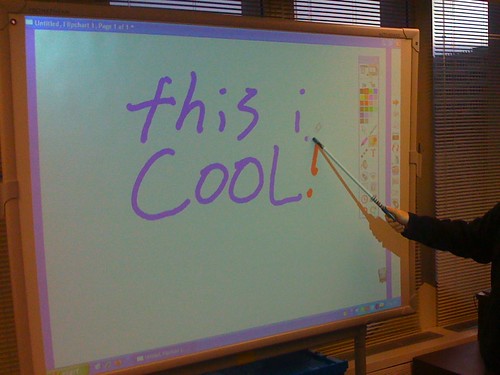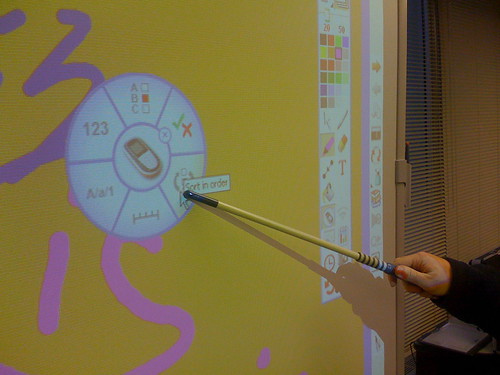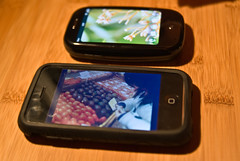I recently had a chance to see and try out the “Activwand” from Promethean designed for use with their electronic white boards.
This wand is definitely cool and fun to use, making one feel a bit like Harry Potter. For shorter students or teachers, it can be handy to permit a longer reach to the upper portions of the electronic whiteboard. It also lets the instructor-of-the-moment stay further out of the projector bulb’s light and cast a smaller shadow on the board itself.
While the wand DOES do magic things when it touches the board, unfortunately we found the command “Wingardium Leviosa” had no apparent effect. Perhaps if we activated universal access features for speech commands on the attached Apple computer this would have produced a result, although I doubt actual levitation is on the feature set yet for ANY electronic whiteboard. (If you talk to an enthusiastic sales person, however, they may assure you that “it’s coming” as a soon-to-be-released feature.)
This “magic wand” and whiteboard experience begs a very basic and important question regarding educational technology, however, which goes beyond the “cool” factor. Is it pedagogically desirable and fiscally responsible for school administrators to spend money on technologies like Activwands and student response systems which predominantly reinforce traditional models of teacher-directed instruction? I contend the answer to this question is NO.
Student response systems are very popular items now at educational technology conferences. One of the more advanced examples is Promethean’s “Activexpression” student remote:
These devices, again, are “pretty cool,” but the functionality they offer is essentially the same as the website service PollEverywhere when students use their OWN cell phones and SMS messaging. PollEverywhere is free to use for polls with less than 31 responses. How do commercial electronic response systems compare? My first question when I saw the Activexpression devices in action was, “How much do they cost?”
The Academic Superstore lists a set of 32 for about $2700 today, which is about $85 each. Yes, these devices DO permit full-text responses, but so does PollEverywhere when students have their own cell phones. MY primary response to commercial electronic response systems like these is the same as it is for the Harry Potter-esque Activwands: I’m NOT impressed. These merely reinforce traditional, teacher-directed instruction. These devices do not offer the same potential to transform and constructively disrupt the learning environment in our schools as laptop computers do when they are given to EVERY student in the spirit of OLPC. I’m not an advocate for merely replacing analog teaching strategies with digital ones and keeping pedagogy consistent. I’m an advocate for the learning revolution, which means I support transformative changes in teaching and learning. Technologies which simply streamline existing administrative functions or support teacher-directed instruction, like the tools above, invite a big yawn from me.
The announcement of Palm’s new Pre operating system at CES this last week is a lot more exciting to me than electronic whiteboard wands or student response systems are. Unlike the iPhone or iPod Touch, the Palm Pre does allow users to copy and paste text. Like the iPhone, the Palm Pre has WiFi access and will permit users to utilize a mind-blowing array of diverse web applications running from “the cloud.”
The best investment in student learning, from an equipment and curriculum standpoint today, is in Netbooks which permit users to not only access and consume media in various formats, but also CREATE and PUBLISH media in diverse formats as well as communicate and collaborate with others. See my December 7th post, “iPhone and iTouch video out functionality, 1 to 1 Learning, and CCC Pedagogy” for more on this.
How can we get our school board members and legislators to understand this? Let’s stop wasting millions of dollars on devices and tools which reinforce the 19th century model of teacher and textbook delivered curriculum. The 21st century is here, including an exponentially growing array of digital curriculum and web apps. We need to empower learners inside and outside of schools with tools (i.e. laptops) which permit them to fully participate as netizens in the 21st century.
If you missed CES in Las Vegas this year (as I did) check out Palm leaders John Rubinstein and Ed Colligan’s presentations about the Palm Pre via video.
The digital learning landscape has just changed again. 🙂
Technorati Tags:
whiteboard, education, polleverywhere, netbook, netbooks, palmpre, palm, pre, ces, ces09, ces2009, promethean, responder, activwand, activboard, activexpression
If you enjoyed this post and found it useful, subscribe to Wes’ free newsletter. Check out Wes’ video tutorial library, “Playing with Media.” Information about more ways to learn with Dr. Wesley Fryer are available on wesfryer.com/after.
On this day..
- Political Philosophy and Media Literacy Cornerstones – 2021
- Why Scratch Club? – 2013
- Temporarily Copy Offline YouTube Videos to Your iPad – 2012
- Claim Your Online Content With Google+ Authorship Settings – 2012
- Misleading Article About Oklahoma Lottery Funds Supplanting Education Funds – 2012
- The Power of Social Media Supporting Collaboration and Creativity: #popupschool at #cwf2010 – 2011
- WordPress Plugins for Database Maintenance and Plugin Listing – 2010
- The MegaVCR: Media and More in Your Pocket – 2007
- Simple Podcasting on a Global Scale – 2007
- Engaging Brains Through Games and Simulations by Bernie Dodge – 2007







Comments
4 responses to “Harry Potter Whiteboard Wands, Responders, and the Palm Pre”
I understand what you mean about some technology being teacher centered. I use a SMART Board (white board) and a student remote system to do some traditional lessons in a new way. While you do not feel they are as valuable as some of the other technologies you mentioned, they still have value. In core academic areas, students must learn some basic knowledge. For example, in English, they still have to learn about plot, conflict, theme, climax, and resolution. Using the remotes or SMART Board is more engaging than teacher lecture. My students ask me to give them quizzes using the remotes. They react more positively when we use the SMART Board.
One can also use these technologies in a more student centered way. The teacher can step back and let the students run the lesson with these tools or groups or individuals can use them to create Power Points and present research. The possibilities are there.
Shannon: I’m not maintaining that IWBs are worthless, I do enjoy teaching with them and in fact will use one tomorrow for my lesson with 5th graders. I’m saying that comparatively speaking, the “bang for the buck” is definitely with laptops and specifically netbooks. This is a minority view where I live in Oklahoma, and I’d hazard a guess in most U.S. school systems today.
Think about how many more different engaged learning opportunities you’d have if every student in your class had a netbook, rather than simply a remote control or a chance to come up to the board and drive the IWB?
I’m also not asserting students don’t need to learn “basics.” We need to BLEND learning to a greater degree with technology tools, letting students access non-interactive lecture content via asynchronously shared videos. See my post “The Synchronous Non-interactive Fallacy” from January 2006 for more on this.
I would tend to agree with your comments about tools that “predominantly reinforce traditional models of teacher-directed instruction”. The only benefit that I can see is that the “cool” factor can be used to keep the attention of students and encourage some degree of interactivity using the technology. How long will this effect last? Who knows?
[…] Wesley Fryer on the Learning Revolution […]